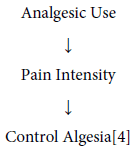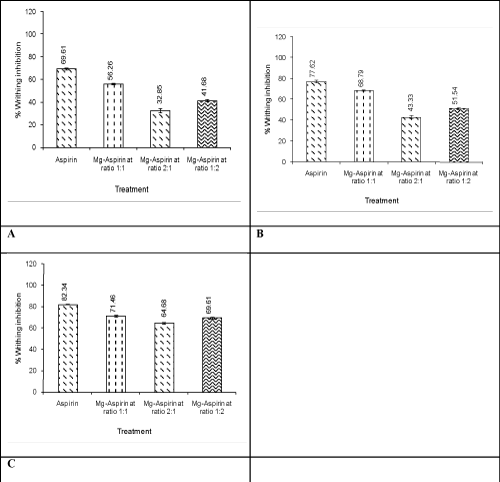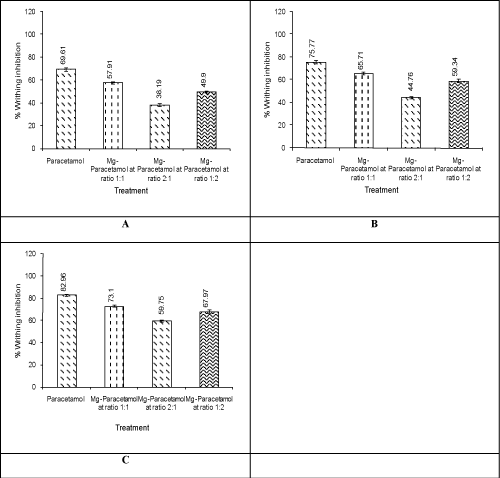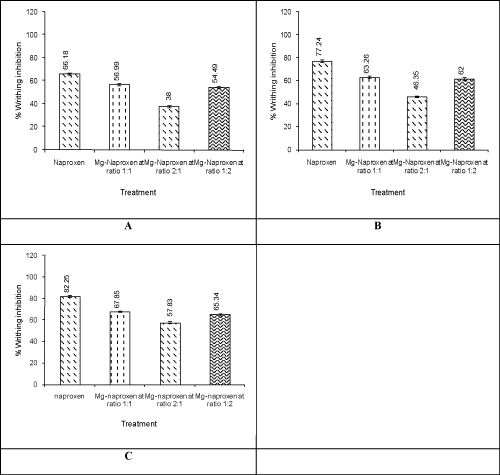Research Article Open Access
The Study of Analgesic Activity of Complexes of Magnesium Sulfate with Aspirin, Paracetamol and Naproxen
| Sangita Paul Kundu1, Md. Zakir Sultan2, Asma Rahman2, Sagar Kumar Paul3, Satabdi Shikder3, Shampa Kundu4, Md. Shah Amran1* and Md.Amjad Hossain1 | |
| 1Department of Pharmaceutical Chemistry, Faculty of Pharmacy, University of Dhaka, Dhaka-1000, Bangladesh | |
| 2Centre for Advanced Research in Sciences, University of Dhaka, Dhaka-1000, Bangladesh | |
| 3Department of Pharmacy, State University of Bangladesh, Dhanmondhi, Dhaka-1205, Bangladesh | |
| 4Department of Pharmacy, Bangladesh University, Mohammadpur, Dhaka-1207, Bangladesh | |
| Corresponding Author : | Md. Shah Amran Department of Pharmaceutical Chemistry Faculty of Pharmacy University of Dhaka, Dhaka-1000, Bangladesh Tel: +8801718617915 Fax: +88029667222 E-mail: amranms@ du.ac.bd |
| Received: July 15, 2015 Accepted: August 24, 2015 Published: August 31, 2015 | |
| Citation:Kundu SP, Sultan MZ, Rahman A, Paul SK, Shikder S, et al. (2015) The Study of Analgesic Activity of Complexes of Magnesium Sulfate with Aspirin, Paracetamol and Naproxen. Clin Pharmacol Biopharm 4:143. doi:10.4172/2167-065X.1000143 | |
| Copyright: © 2015 Kundu SP, et al. This is an open-access article distributed under the terms of the Creative Commons Attribution License, which permits unrestricted use, distribution, and reproduction in any medium, provided the original author and source are credited. | |
Visit for more related articles at Clinical Pharmacology & Biopharmaceutics
Abstract
The study on interaction and complexation of drug molecules with other drugs and various metal ions is an important field of research in the chemical, biochemical, medicinal and pharmacological point of views. The biological action of the drug-metal complexes may affect stability and usual activities of drugs through changing pharmacokinetic and pharmacodynamic properties. The analgesic activity was evaluated by acetic acid induced writhing test in mice. In this experiment, aspirin with magnesium sulfate at the dose of 300 mg, 600 mg and 1.5 g/60 kg body weight, Paracetamol with magnesium sulfate at the dose of 500 mg, at the dose of 1 g and of 2.5 g /60 kg body weight and Naproxen with magnesium sulfate at the dose of 500 mg, at the dose of 1 g and at the dose of 2.5 g/60 kg body weight at a ratio of 1:1, 1:2 and 2:1. It was observed that % inhibition of writhing test of all complex drug of aspirin, paracetamol and naproxen with magnesium sulfate at different ratio were less than the main drug i.e. analgesic activity were lower than the main drug. It is concluded that magnesium sulfate while formed complex as well as mixed with aspirin, paracetamol and naproxen at different ratio suppress the analgesic activity of main drug.
| Keywords |
| Complexation; Aspirin; Paracetamol; Naproxen; Analgesic activity; Pharmacokinetic; Pharmacodynamic; in vivo and in vitro. |
| Introduction |
| The study on interaction and complexation of drug molecules with other drugs and various metal ions is an important field of research in the chemical, biochemical, medicinal and pharmacological point of views. Complexation of drugs with metal ions remarkably influences the bioavailability and other pharmacokinetic properties of drugs in our body. Our body processes a large number of metal ions for operating normal physiological activities and we also intake a number of metals as drug, dietary factor, drinks and in other ways and come in close contact with different drugs. In case of pharmaceutical formulation many metal compounds may be used as API as well as excipients. |
| The biological action of the drug-metal complexes may affect stability and usual activities of drugs through changing pharmacokinetic and pharmacodynamic properties. There are many organometallic compounds which have remarkable pharmacological effects and are used as active ingredients. Magnesium is present in three different states in most biological system: freely coordinated to water, associated with anions and bound to protein. On average, the human body contains approximately 1 mol (24 g) of magnesium. Few other drugs have been tested for as many roles as magnesiumbased drugs have [1]. The proposed curative properties of Mg-based non-steroidal anti-inflammatory drugs (NSAIDs) might lead to the development of some Mg (II) complexes of NSAIDs with enhanced anti-inflammatory activity and reduced gastrointestinal toxicity compared with the parent drug. For this reason, complexation of aspirin, paracetamol and naproxen with metal ions is an interesting field of research. |
| There are several methods to assess the analgesic activity at different steps of pharmacological investigation. The method used to assess the analgesic activity at different steps of pharmacological investigation, was “Acetic acid induced writhing method” [2]. |
| Materials and Methods |
| Materials |
| Aspirin and paracetamol were collected from Square Pharmaceuticals Ltd., Dhaka, Bangladesh; naproxen was collected from SK+F Pharmaceuticals Ltd., Dhaka, Bangladesh. Magnesium sulfate heptahydrate (E. Merk, India, Ltd.), Methanol (Active Fine Chemicals Ltd., Dhaka, Bangladesh), Demineralized water and other reagents were supplied from laboratory 0.9% Sodium Chloride BP and other reagents were analytical grade and purchased from local market. |
| Instruments |
| Centrifuge Machine, HPLC (Shimadzu, Japan). |
| Experimental animal |
| Young Swiss-albino mice aged 4-5 weeks, average weight 20- 25 g were used for the experiment. The mice were purchased from the animal house of the Department of Pharmacy, Jahangirnagar University, Savar, Dhaka, Bangladesh. They were kept in standard environmental conditions in the Animal House, Institute of Food and Nutrition Sciences (IFNS), University of Dhaka, Bangladesh for one week for adaptation after their purchase and fed ICDDR, B formulated rodent food and water ad libitum. The experiment was carried out in the Department of Pharmacy, State University of Bangladesh, Dhanmondi, Dhaka, Bangladesh. |
| The investigation of analgesic activity |
| Analgesia or pain is an unpleasant sensation, usually evoked by external or internal noxious stimulus. Excessive pain may be unbearable and causes other effects- sinking sensation, apprehension, sweating, nausea, palpitation, rise or fall in BP, tachypnea [3]. |
| Analgesic is an agent that reduces or eliminates pain by acting on the sensory nervous system, either centrally or peripherally without significantly altering consciousness. |
| Painful stimuli are deadened but still perceived. Analgesia is controlled by following way- |
 |
| The acetic acid induced writhing method is an analgesic behavioral observation assessment method that demonstrates a noxious stimulation in mice. The test consists of injecting the 0.7 % acetic acid solution intraperitoneally and then observing the animal for specific contraction of body referred as ‘writhing’. A comparison of writhing to be made between positive control, control and test sample. Control, positive control and test sample also to be injected intraperitoneally 5 minutes prior to acetic acid injection. If the sample possesses analgesic activity, the animal that received the sample will give lower number of writhing than the control, i.e. the sample having analgesic activity will inhibit writhing. Aspirin, paracetamol and naproxen are used as reference standard drug for the respective complex drug. The reference standard drug has analgesic, anti-inflammatory and antipyretic actions. These are the important members of nonsteroidal anti-inflammatory drugs. It acts by inhibiting cyclooxygenase [5] |
| Study design |
| 1. Experimental animals were randomly selected and divided into three groups denoted as group-I, group-II, group-III consisting of 5 mice in each group. |
| 2. Each group received a particular treatment i.e. control, positive control and the test samples. |
| 3. Each mouse was weighed properly and the doses of the test samples and control materials were adjusted accordingly. |
| Preparation of test sample |
| To prepare solution 1mg/1 ml of the test samples (Aspirin, paracetamol, Mg-aspirin and Mg-paracetamol at a ratio 1:1, 2:1 and 1:2), 10 mg of samples were measured respectively to 10 ml solution and dilute with 0.9% Sodium chloride BP (Normal saline).To prepare solution 1 mg/1 ml of the test samples (Naproxen, Mg-naproxen at a ratio 1:1, 2:1 and 1:2), 10 mg of samples were measured respectively to 10 ml solution and dilute with phosphate buffer pH 7.4. |
| Methodology |
| The analgesic activity of the complex sample of magnesium sulfate heptahydrate with aspirin, paracetamol and naproxen at molar ratios 1:1, 2:1 and 1:2 was determined by the acetic acid induced writhing inhibition method. The pre-screened Swiss albino mice employed for this experiment were divided into groups depending on the number of samples doses to be applied. The inhibition of writhing in mice by complex samples was compared against inhibition of writhing by a individual drugs (aspirin, paracetamol and naproxen) given intraperitoneal injection at a individual dose. Acetic acid (0.7%) at a dose of 0.1 ml/ 10 g was administered intraperitoneally to create pain sensation. As a result, the animals squirm their body at regular intervals out of pain. The squirm or contraction of the body is termed as writhing. Any substance that has got analgesic activity is supposed to reduce the number of writhing of animals within a given time and with respect to the control groups. The number of writhing was calculated for 30 min 5 minutes after the acetic acid injection. The percentage of pain protection was calculated [6] |
| Data analysis and statistics |
| The acetic acid induced writhing response is a sensitive procedure to evaluate peripherally acting analgesics. The response is thought to be mediate by peritoneal mast cells acid sensing ion channels and the prostaglandin pathway.[7-9] Statistical analysis was based on the guidelines for statistics and modified for the study of in vitro and in vivo studies.[10] The results were expressed as mean ± SD. Differences in mean values between experimental groups (in vitro and in vivo) were analysis by one way analysis of variance, followed by Dunnett’s multiple comparison tests where applicable. A p value less than 0.01 was defined to be significant. |
| Results |
| Data tables for Aspirin |
| Aspirin was administered intraperitoneally to mice at different dose (300 mg, 600 mg and 1.5 g/ 60 kg body weight). The acetic acid induced writhing of mice at different dose is as follows-(Table-1). |
| Data tables for paracetamol |
| Paracetamol was administered intraperitoneally to mice at different dose (500 mg, 1 g and 2.5 g/ 60 kg body weight). The acetic acid induced writhing of mice at different dose is as follows- (Table-2) |
| Data tables for naproxen |
| Naproxen was administered intraperitoneally to mice at different dose (500 mg, 1 g and 2.5 g/ 60 kg body weight). The acetic acid induced writhing of mice at different dose is as follows- (Table-3) |
| Discussion |
| Effect of aspirin at different doses a dose |
| Percent writhing inhibition of the mixture at a dose of 0.3 g/60 kg body weight on acetic acid induced writhing of mice has been found to be 56.26% for (Mg : aspirin) at 1:1 ratio, 32.85% for (Mg : aspirin) at 2:1 ratio and 41.68% for (Mg : aspirin) at 1: 2 ratio, respectively. Whereas percent writhing inhibition for only aspirin at the same dose shown to be 69.61 % on acetic acid induced writhing of mice. It is seen that the writhing inhibition on acetic acid induced mice is higher in case for the standard substance i.e. aspirin, compared to combined forms with the metal salt at a dose of 0.3 g/60kg body weight (Table 1, Figure 1A). |
| Percent writhing inhibition of mixture drug at the dose of 0.6 g/60 kg body weight on acetic acid induced writhing of mice shown 68.79 % for (Mg : aspirin) 1:1 ratio, 43.33 % for (Mg : aspirin) 2:1 ratio and 51.54 % for (Mg : aspirin) 1: 2 ratio respectively. Whereas % writhing inhibition for only aspirin at the same dose shown 77.62 % on acetic acid induced writhing of mice. It is seen again that at a dose of 0.600g/60kg body weight. % writhing inhibition by aspirin is greater than any of its combination with the metal salt. It is also seen that when the extent of aspirin is more (e.g. 1:1 or 2:1) compared to the metal in the mixture, inhibition is more (Table 1, Figure 1B). |
| Percent writhing inhibition of mixture drug at a dose of 1.5g/60kg body weight on acetic acid induced writhing of mice shown 71.46 % for (Mg : aspirin) 1:1 ratio, 64.68% for (Mg : aspirin) 2:1 ratio and 69.61 % for (Mg : aspirin) 1: 2 ratio respectively. Whereas % writhing inhibition for only aspirin at the same dose shown 82.34 % on acetic acid induced writhing of mice. It is seen that the writhing inhibition on acetic acid induced mice is higher in case for the standard substance i.e. aspirin, compared to combined forms with the metal salt at a dose of 1.5 g/60 kg body weight (Table 1, Figure 1C). |
| Effect of paracetamol at different doses |
| Percent writhing inhibition of complex drug of Mg and paracetamol at the dose of 0.500g/60kg body weight on acetic acid induced writhing of mice shown 57.91 % for 1:1 ratio, 38.19 % for 2:1 ratio and 49.90 % for 1: 2 ratio respectively. Whereas % writhing inhibition for only paracetamol at the same dose shown 69.61 % on acetic acid induced writhing of mice. It is seen that the writhing inhibition on acetic acid induced mice is higher in case for the standard substance i.e. paracetamol, compared to combined forms with the metal salt at a dose of 0.500g/60kg body weight (Table 2, Figure 2A). |
| Percent writhing inhibition of complex drug of Mg and paracetamol at the dose of 1g/60kg body weight on acetic acid induced writhing of mice shown 65.71 % for 1:1 ratio, 44.76 % for 2:1 ratio and 59.34 % for 1: 2 ratio respectively. Whereas % writhing inhibition for only paracetamol at the same dose shown 75.77 % on acetic acid induced writhing of mice. It is seen that the writhing inhibition on acetic acid induced mice is higher in case for the standard substance i.e. paracetamol, compared to combined forms with the metal salt at a dose of 1g/60kg body weight (Table 2, Figure 2B). |
| Percent writhing inhibition of complex drug of Mg and paracetamol at the dose of 2.5g/60kg body weight on acetic acid induced writhing of mice shown 73.10% for 1:1 ratio, 59.75 % for 2:1 ratio and 67.97 % for 1: 2 ratio respectively. Whereas % writhing inhibition for only paracetamol at the same dose shown 82.96 % on acetic acid induced writhing of mice. It is seen that the writhing inhibition on acetic acid induced mice is higher in case for the standard substance i.e. paracetamol, compared to combined forms with the metal salt at a dose of 1.5 g/60 kg body weight (Table 2, Figure 2C). |
| Effects of naproxen at different doses |
| Percent writhing inhibition of complex drug of Mg and naproxen at the dose of 0.5 g/60 kg body weight on acetic acid induced writhing of mice shown 56.99 % for 1:1 ratio, 38.0 % for 2:1 ratio and 54.49 % for 1:2 ratio respectively. Whereas % writhing inhibition for only naproxen at the same dose shown 66.18 % on acetic acid induced writhing of mice. It is seen that the writhing inhibition on acetic acid induced mice is higher in case for the standard substance i.e. naproxen, compared to combined forms with the metal salt at a dose of 0.5 g/60 kg body weight (Table 3, Figure 3A). |
| Percent writhing inhibition of complex drug of Mg and naproxen at the dose of 1 g/ 60 kg body weight on acetic acid induced writhing of mice shown 63.26 % for 1:1 ratio, 46.35 % for 2:1 ratio and 62.00 % for 1:2 ratio respectively. Whereas % writhing inhibition for only naproxen at the same dose shown 77.24% on acetic acid induced writhing of mice. It is seen that the writhing inhibition on acetic acid induced mice is higher in case for the standard substance i.e. naproxen, compared to combined forms with the metal salt at a dose of 1g/60 kg body weight (Table 3, Figure 3B). |
| Percent writhing inhibition of complex drug of Mg and naproxen at the dose of 2.5 g/60 kg body weight on acetic acid induced writhing of mice shown 67.85 % for 1:1 ratio, 57.83 % for 2:1 ratio and 65.34 % for 1:2 ratio respectively. Whereas % writhing inhibition for only naproxen at the same dose shown 82.25 % on acetic acid induced writhing of mice. It is seen that the writhing inhibition on acetic acid induced mice is higher in case for the standard substance i.e. naproxen, compared to combined forms with the metal salt at a dose of 2.5g/60kg body weight (Table 3, Figure 3C). |
| Conclusion |
| After all experiment done it was observed that inhibition of % writhing of all complex drug of aspirin, paracetamol and naproxen with magnesium sulfate at different ratio were less than the main drug i.e., analgesic activity were lower than the main drug. |
| It is concluded that magnesium sulfate while formed complex as well as mixed with aspirin, paracetamol and naproxen at different ratio suppress the analgesic activity of main drug. |
| Ethical Approval |
| All authors hereby declared that all experiments were performed in accordance with the ethical standards laid down in the Declaration of Helsinki 1964. |
| Competing Interests |
| Authors have declared that no competing interests exist. |
References
- Gielen, Tiekink (2005) Metallotherapeutic drugs and Metal - Based Diagnostic Agents: The use of Metals in medicine.John Wiley & Sons, Ltd 3: 51-61.
- Whitle BA(1964)The use of changes in capillary permeability in mice to distinguish between narcotic and non-narcotic analgesics. Br. J. Pharmacol. Chemother. 22: 246-253.
- Tripathi KD(2001) Essentials of Medical Pharmacology, Updated Reprint 4th ed. Jaypee Brothers, Medical Publishers (p) LTD.
- Daniel B, Carr MD(1993) Pain Control: The New "Whys" and "How’s" Volume I.
- Ranolds, James EF, Martindale (1982) The Extra Pharmacopoeia, 28th ed; The Pharmaceutical Press. pp.245.
- Rashedul I., Ali M.S. and Alimuzzaman M (2006) Analgesic Activity of the plant extracts of Cissusquadrangularis Linn. The CDR Journal 1: 7-14.
- Ronaldo AR, Mariana LV, Sara MT, Adriana BPP, Steve P, et al.(2000)Involvement of resident macrophages and mast cells in the writhing nociceptive response induced by zymosan and acetic acid in mice. Eur. J. Pharmacol.387: 111-118.
- Voilley N(2004) Acid-Sensing Ion Channels (ASICs): New Targets for the Analgesic effects of Non-Steroid Anti-Inflammatory Drugs (NSAIDs). Current Drug Targets - Inflammation & Allergy3: 71-79.
- Vogel HG, Vogel WH(1997) Pharmacological Analysis. In: Drug Discovery and Evaluation: Springer Verlag, Germany.
- Wallstein S,Zucker CL, Fleiss JL (1980)Some statistical methods useful in circulation research. Circ. Res. 47: 1-9.
Tables and Figures at a glance
| Table 1 | Table 2 | Table 3 |
Figures at a glance
 |
 |
 |
| Figure 1 | Figure 2 | Figure 3 |
Relevant Topics
- Applied Biopharmaceutics
- Biomarker Discovery
- Biopharmaceuticals Manufacturing and Industry
- Biopharmaceuticals Process Validation
- Biopharmaceutics and Drug Disposition
- Clinical Drug Trials
- Clinical Pharmacists
- Clinical Pharmacology
- Clinical Research Studies
- Clinical Trials Databases
- DMPK (Drug Metabolism and Pharmacokinetics)
- Medical Trails/ Drug Medical Trails
- Methods in Clinical Pharmacology
- Pharmacoeconomics
- Pharmacogenomics
- Pharmacokinetic-Pharmacodynamic (PK-PD) Modeling
- Precision Medicine
- Preclinical safety evaluation of biopharmaceuticals
- Psychopharmacology
Recommended Journals
Article Tools
Article Usage
- Total views: 14745
- [From(publication date):
August-2015 - Sep 02, 2025] - Breakdown by view type
- HTML page views : 10085
- PDF downloads : 4660
